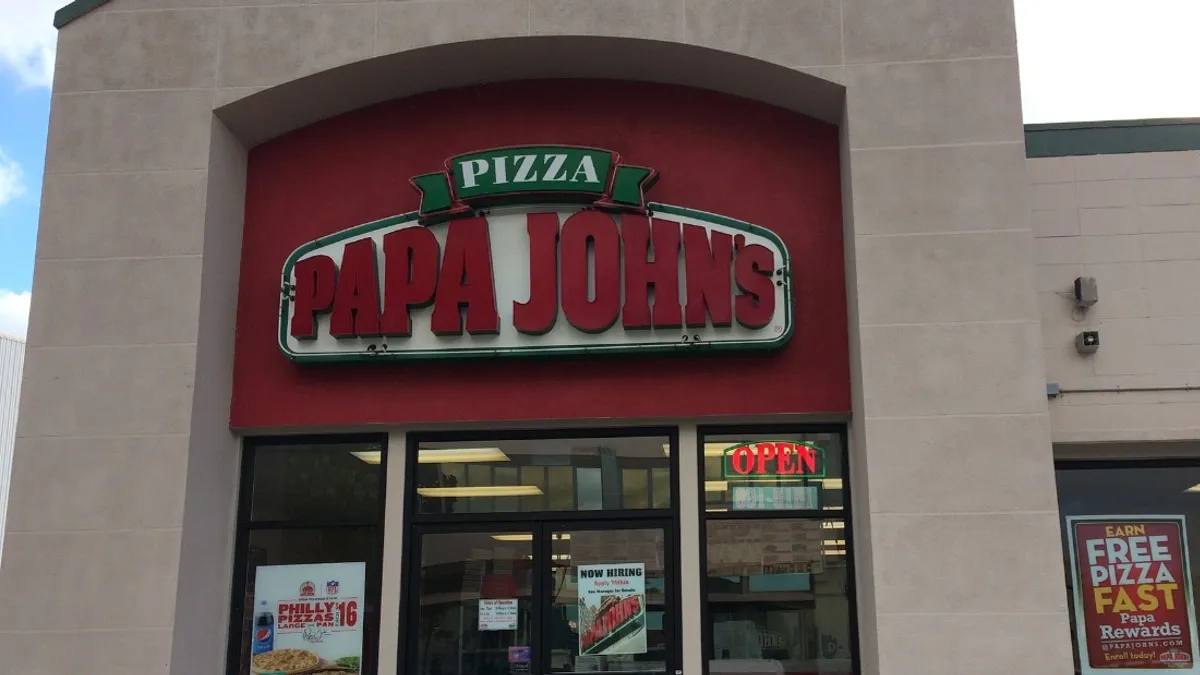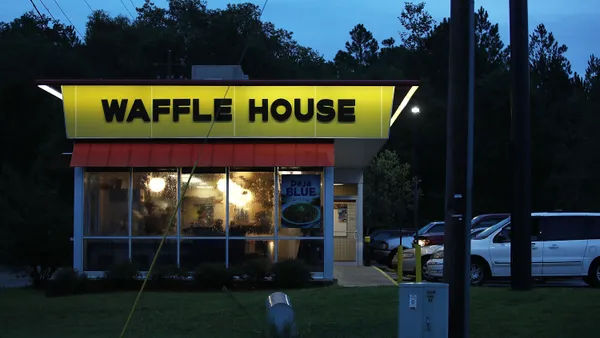UPDATE, May 7, 2020: April was Papa John's strongest month in the company's 35-year history, with the chain reporting a 27% increase in comp sales for North America, CEO Rob Lynch said during an earnings call on May 6. About 10% of that sales growth is likely due to COVID-19, Lynch said. Transaction size grew 25% among Papa Rewards customers. "But this surge in demand is also introducing Papa John's brand [to] new customers, including more than 1 million new and lapsed customers in April on our digital channels alone," Lynch said.
Dive Brief:
- Papa John's North America restaurants experienced and estimated same-store sales growth of 5.3% for the first quarter, according to a company release. The pizza chain plans to release its Q1 earnings in May.
- Domestic company-owned restaurants recorded a 6.1% increase in same-store sales, and North American franchised restaurants posted a 5.1% increase.
- "Although March sales in North America were negatively impacted by the cancellation of large gatherings, including major sporting events, our international and domestic businesses have performed well, as customers and communities rely on us and others in the food delivery industry," Papa John's President and CEO Rob Lynch said in a statement. "Our cash position is supporting our current operations, and we have access to approximately $350 million in our credit facility, should we need it."
Dive Insight:
As COVID-19 restrictions pummel the restaurant industry in March and April, pizza chains are virtually the only subsegment that have experienced a windfall in the past few weeks. But this piece of Papa John's Q1 performance is especially significant given the restaurant's frequent same-store sales declines since Q4 2017, reaching a peak of negative 7.3% in 2018. While its 2019 comparable sales declined 2.2% for its North American restaurants, the company has reported positive comparable sales since Q3 2019, according to an SEC filing.
It's possible that the growth Papa John's is experiencing thanks to widespread delivery-only mandates could be the final boost it needs to move beyond a long period of instability following John Schnatter's ouster. It leaned heavily on three delivery partnerships that were already in place that allowed it to scale delivery to more customers during peak times, Lynch told investors, adding that the percentage of deliveries from aggregators more than doubled year-over-year with 4% of its business now coming from aggregators. It was the first pizza delivery company to fully integrate no contact delivery into its digital ordering channels, Lynch said. The relaunch of its rewards program also helped draw customers back to the chain and it now has over 16 million members, he said.
What is likely also helping is an $80 million investment toward marketing and financial assistance toward domestic franchisees it make last year around the same time it brought on Shaquille O'Neal as a brand ambassador and board member. In March, it said that it's hiring 20,000 new employees to keep up with current demand alongside Domino's and Pizza Hut, which plan to hire 10,000 and 30,000 new workers, respectively.
This is an about-face for Papa John's, which partnered with third-party delivery platforms to supplement its delivery fleet — which saw 220% driver turnover last year — because drivers were scarce. Now that sweeping layoffs have people looking for work and delivery demand is at an all-time high, the restaurant stands to seriously benefit for the foreseeable future. Not every pizza chain has seen sizable gains, however. Domino's reported that its U.S. same-store sales growth shrunk by over 50% during Q1 2020, for example. It also announced it temporarily closed 1,400 restaurants worldwide. But it seems likely that going forward, pizza chains will continue to see gains from the current climate.














